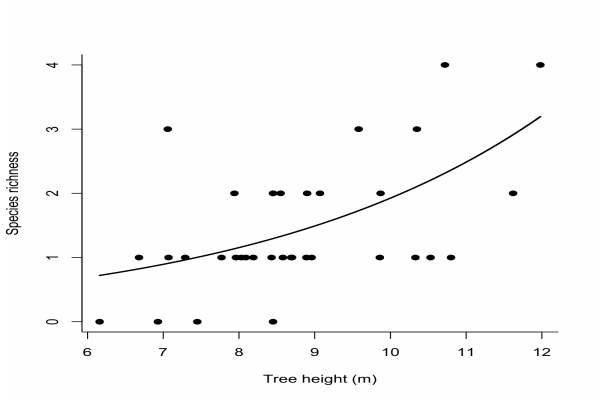Painéis
Local environmental drivers of litter cricket diversity in Atlantic forest regeneration patches
Atlantic forest of southeastern Brazil has suffered intensive deforestation, being reduced to less than 10% of its pristine area, with the remaining forest being mostly restricted to small habitat fragments. Large areas of this region have presently their forests located at hill tops, partially because of specific environmental laws, but also because several of these areas are abandoned coffee plantations, where the forest is regenerating. Here we evaluated if there are local environmental drivers of forest litter cricket diversity in these habitat. Our hypotheses were that primary productivity, forest regeneration status, habitat structural complexity or spatial heterogeneity affected cricket diversity. We sampled 18 secondary forest fragments reaching from 3.15 to 299ha, scattered within a 400km2 area around the city of Viçosa, MG, Brazil. Each fragment was divided in equal 5ha quadrants, drawn on aerial photographs, so as to choose randomly the quadrants to be sampled. Sampling effort (n=36) was proportional to fragment size, with one sampling unit in small (up to 8.6ha), four in medium (30 to 61ha), and six in large (> 93ha) fragments. Each sampling unit had 12 pitfall traps, in four groups of three traps, with at least 30m among groups, which were left for 48h in the field. We tested if the following local environmental variables affected litter cricket diversity: trunk diameter, tree height and standing tree biomass (=trunk diameter x tree height); distance among trees, presence of lianas or of pioneer tree species (assumed to be inversely correlated to regeneration stage); density of understory (as an estimate of habitat structure complexity) and tree height (an estimate of vertical stratification); and variance/mean ratio of tree trunk diameter, distance among tees, tree height and density of understory (as estimates of spatial habitat heterogeneity). We adjusted generalized linear models, with Poisson errors, using number of cricket species as response variable. Explanatory variables were all numerical, so that all analyses corresponded to multiple regressions. We evaluated significance of effects comparing nested models with 2 test, so as to attain the minimum adequate model. Cricket species richness increased with tree height (2 =7.05, P= 0.007, Figure 1). All remaining local environmental variables did not affect cricket species richness (P>0.17). Tree Height positively influenced cricket richness, which can be interpreted as a positive effect on the regeneration time diversity of cricket. That is, the presence of old trees requires a greater degree of succession, and therefore, fragments of wood with better quality and number of habitats. Tree Height can also be indicative of habitat structural complexity. We know that habitat complexity increases richness of insects in general and may explain the greater diversity of cricket found at these sites. Vegetation structure changes the microclimatic conditions of environment. As crickets are organisms susceptible to those microclimate conditions, locations with higher trees should provide conditions of light, temperature and humidity favorable for these insects. In addition, these conditions may allow higher proliferation of fungi and greater quantities of litter, which represents food resources and shelter for crickets. The results of this study suggest environmental variable such as tree height can be Local environmental driver of cricket litter diversity in secondary Atlantic forest.
JESUS, F. M.; OLIVEIRA, G. L. & SPERBER, C. F. Local environmental drivers of litter cricket diversity in secondary Atlantic forest. In: 11th nternational Congress of Orthopterology, Kuniming, China, 2013.
Acknowledgments. Grants (CFS, FMJ & GLO) and financial support provided by CAPES, CNPq and FAPEMIG, Proc. 563360/2010-0 — EditalMCT/CNPq/MMA/MEC/CAPES/FNDCT – SISBIOTA


